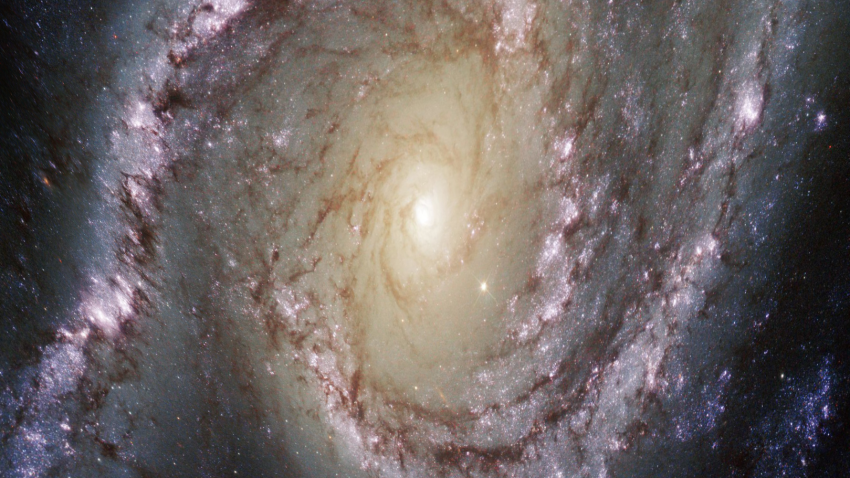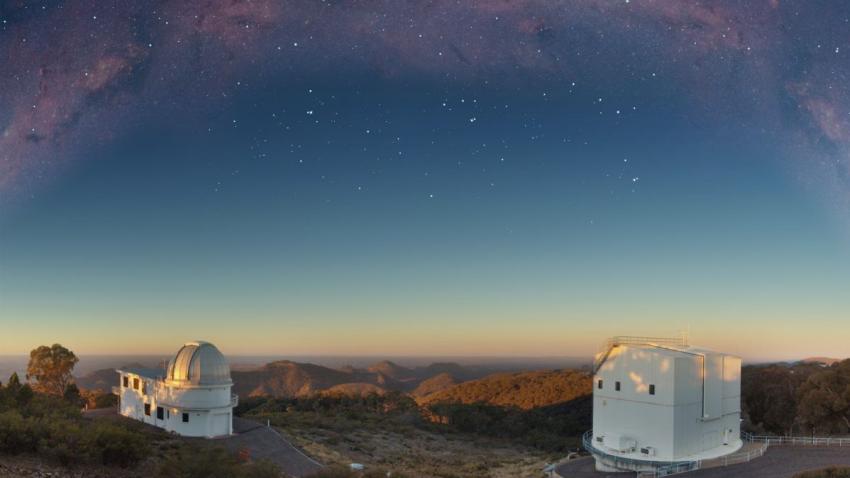A small team of astronomers have found a new way to ‘see’ the elusive dark matter haloes that surround galaxies, with a new technique 10 times more precise than the previous-best method. The work is published in Monthly Notices of the Royal Astronomical Society.
Scientists currently estimate that up to 85% of the mass in the universe is effectively invisible. This ‘dark matter’ cannot be observed directly, because it does not interact with light in the same way as the ordinary matter that makes up stars, planets, and life on Earth.
So how do we measure what cannot be seen? The key is to measure the effect of gravity that the dark matter produces.
Pol Gurri, the PhD student at Swinburne University of Technology who led the new research, explains: “It’s like looking at a flag to try to know how much wind there is. You cannot see the wind, but the flag’s motion tells you how strongly the wind is blowing.”
The new research focuses on an effect called weak gravitational lensing, which is a feature of Einstein’s general theory of relativity. “The dark matter will very slightly distort the image of anything behind it,” says Associate Professor Edward Taylor, who was also involved in the research. “The effect is a bit like reading a newspaper through the base of a wine glass.”
Weak gravitational lensing is already one of the most successful ways to map the dark matter content of the Universe. Now, the Swinburne team has used the ANU 2.3m Telescope in Australia to map how gravitationally lensed galaxies are rotating. “Because we know how stars and gas are supposed to move inside galaxies, we know roughly what that galaxy should look like,” says Gurri. “By measuring how distorted the real galaxy images are, then we can figure out how much dark matter it would take to explain what we see.”
The new research shows how this velocity information enables a much more precise measurement of the lensing effect than is possible using shape alone. “With our new way of seeing the dark matter,” Gurri says, “we hope to get a clearer picture of where the dark matter is, and what role it plays in how galaxies form.”
Future space missions such as NASA’s Nancy Grace Roman Space Telescope and the European Space Agency’s Euclid Space Telescope are designed, in part, to make these kinds of measurements based on the shapes of hundreds of millions of galaxies. “We have shown that we can make a real contribution to these global efforts with a relatively small telescope built in the 1980s, just by thinking about the problem in a different way,” adds Taylor.
Media contacts
Dr Morgan Hollis
Royal Astronomical Society
Mob: +44 (0)7802 877 700
press@ras.ac.uk
Dr Robert Massey
Royal Astronomical Society
Tel: +44 (0)20 7292 3979
Mob: +44 (0)7802 877 699
press@ras.ac.uk
Science contacts
Mr Pol Gurri
Swinburne University of Technology
Centre for Astrophysics and Supercomputing
Australia
Tel: +61 466 289 019
pgurriperez@swin.edu.au
Assoc. Prof. Edward Taylor
Swinburne University of Technology
Centre for Astrophysics and Supercomputing
Australia
Tel: +61 406 818 266
entaylor@swin.edu.au
Prof. Chris Fluke
Swinburne University of Technology
Centre for Astrophysics and Supercomputing
Australia
cfluke@swin.edu.au
Images and captions
Further information
The new work appears in, “The first shear measurements from precision weak lensing”, P. Gurri, E.N. Taylor, C.J. Fluke, Monthly Notices of the Royal Astronomical Society (2020), in press (DOI: 10.1093/mnras/staa2893).
The paper is available from: https://doi.org/10.1093/mnras/staa2893
This research was partially funded by the Australian Government through an Australian Research Council Future Fellowship (FT150100269) awarded to E.N. Taylor.
Notes for editors
The Royal Astronomical Society (RAS), founded in 1820, encourages and promotes the study of astronomy, solar-system science, geophysics and closely related branches of science. The RAS organises scientific meetings, publishes international research and review journals, recognises outstanding achievements by the award of medals and prizes, maintains an extensive library, supports education through grants and outreach activities and represents UK astronomy nationally and internationally. Its more than 4,400 members (Fellows), a third based overseas, include scientific researchers in universities, observatories and laboratories as well as historians of astronomy and others.
The RAS accepts papers for its journals based on the principle of peer review, in which fellow experts on the editorial boards accept the paper as worth considering. The Society issues press releases based on a similar principle, but the organisations and scientists concerned have overall responsibility for their content.
In 2020 the RAS is 200 years old. The Society is celebrating its bicentennial anniversary with a series of events around the UK, including public lectures, exhibitions, an organ recital, a pop-up planetarium, and the culmination of the RAS 200: Sky & Earth project.
Follow the RAS on Twitter, Facebook, Instagram and YouTube
Download the RAS Podcast from Audioboom





